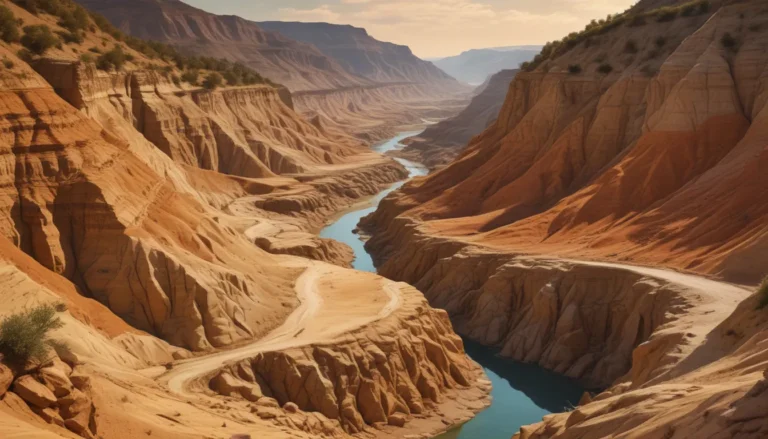A Note About Images: The images used in our articles are for illustration purposes only and may not exactly match the content. They are meant to engage readers, but the text should be relied upon for accurate information.
Welcome to the mesmerizing world of floodplains, where nature’s beauty and resilience meet to create dynamic landscapes essential for our ecosystem. In this educational journey, we will explore 18 captivating facts about floodplains that highlight their significance in flood control, biodiversity, and agriculture. From their role in supporting diverse wildlife to their economic benefits, floodplains have a lot to offer. Join us as we unravel the mysteries of floodplains and appreciate the vital role they play in sustaining our world.
Understanding Floodplains: Nature’s Resilient Ecosystems
Floodplains, flat or nearly flat areas adjacent to rivers and streams, experience periodic flooding and play a crucial role in the natural cycle of water. These landscapes are formed by sediments deposited during flood events and support a rich variety of plant and animal species. The regular flooding helps replenish soil nutrients, creating dynamic environments suitable for diverse habitats.
Delving Into Floodplains’ Multifaceted Functions
-
Vital Role in Flood Control: Floodplains act as natural buffers during heavy rainfall and snowmelt events, providing storage areas for excess water to reduce the risk of downstream flooding.
-
Agricultural Hotspots: Known for their fertile soils, floodplains are ideal for agriculture, supporting crop production and grazing for many farmers.
-
Groundwater Recharge: When inundated with water, floodplains contribute to recharging underground water sources, maintaining water levels in wells and aquifers.
-
Natural Habitat for Wildlife: Crucial habitats for various species, floodplains offer abundant food resources and shelter options for wildlife.
Exploring the Diversity of Floodplain Landscapes
-
Formation of Meanders: Over time, floodwaters erode outer river banks and deposit sediment on inner banks, creating meanders that shape floodplain landscapes.
-
Dynamic and Ever-Changing: Shaped by natural forces, floodplains are constantly evolving with the ebb and flow of water, making them fascinating areas for study.
-
Economic Benefits: Floodplains provide opportunities for recreational activities like fishing, boating, and birdwatching, boosting tourism and local economies.
Addressing Challenges and Conservation Efforts
-
Human Settlements: Floodplains have attracted human settlements for centuries due to fertile soils, posing challenges for flood management and disaster resilience.
-
Water Filtration: Acting as natural filters, floodplains remove pollutants from floodwaters, enhancing water quality and maintaining healthy ecosystems.
-
Restoration Projects: Many countries are focusing on preserving and restoring floodplain ecosystems to enhance flood protection, biodiversity, and overall environmental health.
Navigating the Historical Significance and Future Prospects
-
Historical Importance: Floodplains have played crucial roles in human history, providing fertile grounds for agriculture, transportation routes, and trade hubs.
-
Climate Change Challenges: With increasing extreme weather events, floodplains face vulnerability, requiring effective management and adaptation strategies.
-
Collaboration for Conservation: Integrating scientific research and traditional knowledge systems in floodplain management ensures a holistic approach to preserving these vital ecosystems.
Empowering Through Education and Awareness
Creating awareness about floodplains is essential to foster responsibility and informed decision-making for their preservation. Education empowers individuals to appreciate the critical role floodplains play in maintaining environmental balance.
Embracing the Future of Floodplain Management
With advancements in technology and a better understanding of floodplain dynamics, the future holds promise for mitigating flood impacts and protecting these unique environments. Floodplains act as natural reservoirs, storing excess water during flood events and gradually releasing it to minimize downstream flood risks.
Conclusion: Embracing the Marvels of Floodplains
In conclusion, floodplains are dynamic geographical features that are crucial for our ecosystem’s balance. Understanding their unique characteristics and functions can help mitigate flooding impacts and protect our communities from natural disasters. By appreciating the wonders of floodplains, we can nurture a deeper connection with nature and contribute to their preservation for generations to come.
FAQs: Unveiling Floodplain Mysteries
-
What is a floodplain? – A flat or low-lying area adjacent to a water body prone to flooding.
-
How are floodplains formed? – Deposited sediment from rivers creates flat, fertile land over time.
-
Are floodplains developed? – Development must consider risks and impacts on floodplain functions.
-
How do floodplains benefit wildlife? – Providing habitats, food sources, breeding grounds, and migration routes for diverse species.
As we embark on this journey of discovery, let’s celebrate the marvels of floodplains and their essential contributions to our world. Join us in exploring the captivating world of floodplains, where nature’s resilience and beauty harmonize to sustain life as we know it.






